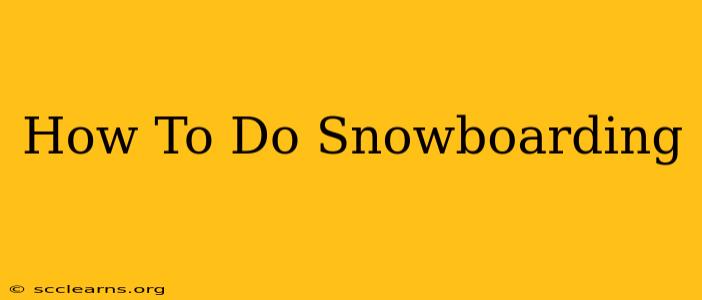So, you're ready to conquer the snowy mountains and experience the thrill of snowboarding? Fantastic! Snowboarding is an incredibly rewarding sport, but it takes practice and patience. This guide will walk you through the basics, helping you get comfortable on the board and eventually carving down the slopes with confidence.
Getting Started: Gear Up!
Before you even think about hitting the slopes, you need the right gear. This isn't just about looking cool; proper equipment is crucial for safety and comfort.
Essential Snowboarding Gear:
- Snowboard: Rent a board initially to find the right size and style for your skill level. Don't invest in a board until you've got some experience.
- Boots: These are just as important as the board. Comfortable, well-fitting boots are essential for control and preventing injury. Rental shops can help you find the right fit.
- Bindings: These attach your boots to the board. Make sure they're properly adjusted by a professional at the rental shop.
- Helmet: This is non-negotiable. Head injuries are a serious risk in snowboarding, so a helmet is a must-have, regardless of your skill level.
- Goggles: Protect your eyes from the sun, wind, and snow.
- Snowboard jacket and pants: Waterproof and insulated outerwear is crucial for staying warm and dry.
- Gloves or mittens: Keep your hands warm and protected.
- Base layers: These wick away moisture and keep you warm.
Mastering the Basics: From Flat Ground to the Slopes
Learning to snowboard takes time and dedication. Start slow and focus on mastering the fundamentals before attempting anything challenging.
Getting Comfortable on Flat Ground:
- Strapping in: Practice getting in and out of your bindings on flat ground. This might seem trivial, but it's important to get comfortable with the process before you're on a slope.
- Finding your balance: With your boots strapped in, try to stand up and find your balance. This will feel awkward at first, but practice makes perfect.
- Heel edge and toe edge: Get a feel for the difference between leaning on your heel edge (the back of the board) and your toe edge (the front of the board). This is fundamental to controlling your speed and direction.
Hitting the Slopes (Beginner Hill):
- The "hockey stop": This is a basic braking technique. Start by gently leaning back onto your heel edge, gradually increasing the pressure until you come to a stop.
- Falling leaf: This technique helps you navigate gentle slopes and get a feel for turning. Practice shifting your weight from your heel edge to your toe edge, initiating a controlled turn.
- Riding the lift: Learn how to safely board a lift (chairlift or surface lift) and get off. This is an essential skill for accessing different parts of the mountain.
Progressing Your Skills: Intermediate and Beyond
Once you've mastered the basics, you can start working on more advanced techniques:
- Carving: This involves making smooth, controlled turns using the edges of your board.
- Jumping: This requires good balance, timing, and technique. Start with small jumps and gradually work your way up.
- Riding different terrain: Explore different types of slopes and terrain, such as moguls (bumps) and glades (trees).
Safety First: Always Remember These Tips
- Never snowboard alone. Always go with a friend or take lessons from a qualified instructor.
- Check the weather forecast before heading out to the slopes.
- Be aware of your surroundings. Pay attention to other snowboarders and skiers.
- Respect the mountain. Stay within your skill level and don't attempt anything beyond your capabilities.
- Always wear a helmet.
Snowboarding is a fantastic sport that offers endless opportunities for fun and adventure. By starting with the basics, practicing regularly, and prioritizing safety, you’ll be carving down the slopes like a pro in no time. Remember to be patient, persistent, and most importantly, have fun!

